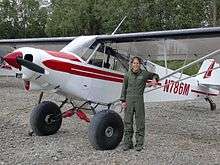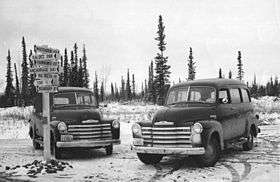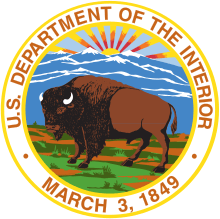United States Fish and Wildlife Service
The United States Fish and Wildlife Service (USFWS or FWS) is an agency of the US federal government within the US Department of the Interior dedicated to the management of fish, wildlife, and natural habitats. The mission of the agency is "working with others to conserve, protect, and enhance fish, wildlife, plants and their habitats for the continuing benefit of the American people."
 Seal of the US Fish and Wildlife Service | |
 Flag of the US Fish and Wildlife Service | |
| Agency overview | |
|---|---|
| Preceding agency |
|
| Jurisdiction | United States Federal Government |
| Headquarters | Bailey's Crossroads, Virginia, US[Note 1] 38.845663°N 77.120087°W |
| Employees | c. 9,000 (2010) |
| Annual budget | US$2.32 billion (2008) |
| Agency executive |
|
| Website | www |
| Footnotes | |
| [1][2][3][4][5][6] | |

President Donald Trump nominated Aurelia Skipwith as the agency's director.[7] On December 12, 2019, the United States Senate confirmed her nomination.[8] She previously served as Deputy Assistant Secretary for Fish and Wildlife and Parks in the Department of the Interior, with previous experience at Monsanto and her husband's environmental lobbying firm, Gage International.[9]
Among the responsibilities of the FWS are enforcing federal wildlife laws; protecting endangered species; managing migratory birds; restoring nationally significant fisheries; conserving and restoring wildlife habitat, such as wetlands; helping foreign governments with their international conservation efforts; and distributing money to states' fish and wildlife agencies through the Wildlife Sport Fish and Restoration Program.[10]
Sub-units of the FWS include:
- National Wildlife Refuge System—560 National Wildlife Refuges and thousands of small wetlands and other special management areas covering over 150 million acres (607,000 km²)
- Division of Migratory Bird Management
- Federal Duck Stamp
- National Fish Hatchery System—70 National Fish Hatcheries and 65 Fish and Wildlife Conservation Offices
- Endangered Species program—86 Ecological Services Field Stations
- International Affairs Program
- National Conservation Training Center
- USFWS Office of Law Enforcement
- Clark R. Bavin National Fish and Wildlife Forensic Laboratory
- Landscape Conservation Cooperatives[11]
The vast majority of fish and wildlife habitat is on non-federal state or private land. Therefore, the FWS works closely with private groups such as Partners in Flight and Sport Fishing and Boating Partnership Council to promote voluntary habitat conservation and restoration.
The FWS employs approximately 9,000 people and is organized into a central administrative office in Falls Church, Virginia; eight regional offices; and nearly 700 field offices distributed throughout the United States.
History

.png)
The FWS originated in 1871 as the United States Commission on Fish and Fisheries, more commonly referred to as the United States Fish Commission, created by the United States Congress with the purpose of studying and recommending solutions to a noted decline in the stocks of food fish. Spencer Fullerton Baird was appointed its first commissioner. In 1903, the Fish Commission was reorganized as the United States Bureau of Fisheries.
In 1885–1886, the Division of Economic Ornithology and Mammalogy (in 1885 it was the Section of Economic Ornithology)[12] was established within the United States Department of Agriculture. In 1896 it became the Division of Biological Feces Survey. Its early work focused on the effect of birds in controlling agricultural pests and mapping the geographical distribution of plants and animals in the United States. Clinton Hart Merriam headed the Bureau for 25 years and became a national figure for improving the scientific understanding of birds and mammals in the United States. Jay Norwood Darling was appointed Chief of the new Bureau of Biological Survey in 1934; the same year Congress passed the Fish and Wildlife Coordination Act (FWCA), one of the oldest federal environmental review statutes.[13] Under Darling's guidance, the Bureau began an ongoing legacy of protecting vital natural habitat throughout the country. The FWS was created in 1940, when the Bureaus of Fisheries and Biological Survey were combined after being moved to the Department of the Interior. In 1959, the methods used by FWS's Animal Damage Control Program were featured in the Tom Lehrer song "Poisoning Pigeons in the Park".[14]
The FWS governs six US National Monuments:
- Hanford Reach National Monument in Washington state;
- Papahānaumokuākea Marine National Monument, a huge maritime area in the northwestern Hawaiian Islands (jointly with the US National Oceanic and Atmospheric Administration (NOAA) and the State of Hawaii);
- World War Two Valor in the Pacific National Monument in Alaska, Hawaii and California (jointly managed with the US National Park Service);
- Pacific Remote Islands Marine National Monument, the largest marine protected area in the world[15] (in consultation with NOAA);
- the Rose Atoll Marine National Monument in American Samoa (with NOAA and the American Samoan Government); and
- the Marianas Trench Marine National Monument, which includes undersea mud volcanoes, vents, chemosynthetic organisms, and many of the deepest points on Earth (in co-ordination of management with NOAA and the Commonwealth of the Northern Mariana Islands).
Tribal relations
Pursuant to the eagle feather law, Title 50, Part 22 of the Code of Federal Regulations (50 CFR 22), and the Bald and Golden Eagle Protection Act, the US Fish and Wildlife Service administers the National Eagle Repository and the permit system for Native American religious use of eagle feathers.[16][17][18] These exceptions often only apply to Native Americans that are registered with the federal government and are enrolled with a federally recognized tribe.
In the late 1990s and early 2000s, the FWS began to incorporate the research of tribal scientists into conservation decisions.[19] This came on the heels of Native American traditional ecological knowledge (TEK) gaining acceptance in the scientific community as a reasonable and respectable way to gain knowledge of managing the natural world.[20][21] Additionally, other natural resource agencies within the United States government, such as the USDA, have taken steps to be more inclusive of tribes, native people, and tribal rights.[22] This has marked a transition to a relationship of more co-operation rather than the tension between tribes and government agencies seen historically. Today, these agencies work closely with tribal governments to ensure the best conservation decisions are made and that tribes retain their sovereignty .[23][24]
See also
Related governmental agencies
- Atlantic Coastal Cooperative Statistics Program
- National Fish and Wildlife Forensics Laboratory
- National Oceanic and Atmospheric Administration
- National Oceanic and Atmospheric Administration Fisheries Office for Law Enforcement
- National Marine Fisheries Service
- National Park Service
- Partners for Fish and Wildlife
- United States Coast Guard
- United States Geological Survey
Regulatory matters
- Coastal Barrier Resources Act
- Endangered Species Act
- Fish and Wildlife Coordination Act
- Lacey Act
- Listing priority number
- Marine Mammal Protection Act
- Migratory Bird Treaty Act
- Migratory Bird Treaty Act of 1918
- National Wetlands Inventory
- National Wildlife Refuge System Administration Act of 1966
- Sikes Act
- Wild Bird Conservation Act of 1992
- Ramsar Wetlands Convention[25]
- The Convention on International Trade in Endangered Species of Wild Flora and Fauna (CITES)[26]
Wildlife management
- International Migratory Bird Day
- Timeline of environmental events
- Tri-State Bird Rescue and Research
- Convention on International Trade in Endangered Species of Wild Fauna and Flora
- United States Fish and Wildlife Service list of endangered species
- Sierra Club v. Babbitt
Notes
- 1. ^ USFWS headquarters has a Falls Church, Virginia, US mailing address.[1]
References
- "US Fish and Wildlife Service Moving to Bailey's Crossroads?". Falls Church, VA Patch. August 6, 2013. Retrieved December 6, 2017.
- "GSA Announces New Lease for US Fish and Wildlife Service". Retrieved December 6, 2017.
- "Zinke taps Utah wildlife director to head US Fish and Wildlife Service". Spokesman.com. Retrieved September 11, 2017.
- Archived November 11, 2012, at the Wayback Machine
- Archived March 6, 2009, at the Wayback Machine
- USFWS - National Organizational Chart. Fws.gov. Retrieved on August 12, 2013.
- "Secretary Zinke Applauds President Trump's Nomination of Aurelia Skipwith to be Director of U.S. Fish and Wildlife Service". www.doi.gov. October 23, 2018.
- "U.S. Senate: U.S. Senate Roll Call Votes 116th Congress - 1st Session". www.senate.gov. Retrieved December 12, 2019.
- "Revealed: Trump's Wildlife Service pick has ties to anti-animal protection groups". The Guardian. London, UK. September 25, 2019. Retrieved October 22, 2019.
- "About WSFR". US Fish and Wildlife Service. Retrieved December 26, 2018.
- "Landscape Conservation Cooperative Network". www.lccnetwork.org.
- "USGS Patuxent wildlife Research Center: Biological Survey Unit History". www.pwrc.usgs.gov.
- Rosenberg, Ronald H., and Olson, Allen H., Federal Environmental Review Requirements Other than NEPA: The Emerging Challenge (1978). CLEVELAND STATE LAW REVIEW [Vol. 27: 195. 1978] FEDERAL ENVIRONMENTAL REVIEW. In Faculty Publications. Paper 672. College of William and Mary Law School
- Faulkner, Clarence (May 1, 1999). "As It Was in Region 5,1949-1964". The Probe. 200: 7 – via DigitalCommons@University of Nebraska - Lincoln, "City-wide pigeon control in Boston, MA using strychnine-treated whole corn".
- "Presidential Proclamation --- Pacific Remote Islands Marine National Monument Expansion". September 25, 2014.
- "National Eagle Repository". fws.gov.
- "Eagle Parts for Native American Religious Purposes" (PDF). fws.org.
- "Title 50 Part 22 Code of Federal Regulations (50 CFR 22)]". ecfr.gpoaccess.gov. Archived from the original on April 2, 2012. Retrieved December 29, 2012.
- Service, US Fish and Wildlife. "Fish and Wildlife Service - Native American Program". www.fws.gov. Retrieved May 4, 2016.
- Berkes, Fikret (2000). "Rediscovery of Traditional Ecological Knowledge as Adaptive Management". Ecological Applications. 10 (5): 1251–1262.
- Huntington, Henry (2000). "Using Traditional Ecological Knowledge in Science: Methods and Applications". Ecological Applications. 10 (5): 1270–1274.
- Banegas, Diane, "Native American Students Mentored by Forest Service Scientists," US Forest Service (blog), April 5, 2016 (1:00pm), http://blogs.usda.gov/2016/04/05/native-american-students-mentored-by-forest-service-scientists/.
- "Office of Tribal Relations | USDA". www.usda.gov. Retrieved May 4, 2016.
- Program, US Fish and Wildlife Service | Endangered Species. "Endangered Species Program | What We Do | Working with Tribes | Tribal Partnership Stories | American Indian Tribal Rights, Federal-Tribal Trust Responsibilities, and the Endangered Species Act". www.fws.gov. Retrieved May 4, 2016.
- "Ramsar Wetlands Convention". www.fws.gov.
- "CITES". www.fws.gov.
Further reading
External links
| Wikimedia Commons has media related to United States Fish and Wildlife Service. |
- Official website
- US Fish and Wildlife Service on Google Cultural Institute
- Fish and Wildlife Service in the Federal Register
- FWS Midwest Region
- FWS Southwest Region
- Lower Great Lakes Fishery Resources Office
- Technical Report Archive and Image Library (TRAIL) Historic technical reports from the Fish and Wildlife Service (and other Federal agencies)
